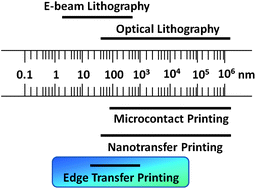The exploration of new methods and techniques for application in diverse fields, such as photonics, microfluidics, biotechnology and flexible electronics is of increasing scientific and technical interest for multiple uses over distance of 10–100 nm. This article discusses edge transfer printing — a series of unconventional methods derived from soft lithography for nanofabrication. It possesses the advantages of easy fabrication, low-cost and great serviceability. In this paper, we show how to produce exposed edges and use various materials for edge transfer printing, while nanoskiving, nanotransfer edge printing and tunable cracking for nanogaps are introduced. Besides this, different functional materials, such as metals, inorganic semiconductors and polymers, as well as localised heating and charge patterning, are described here as unconventional “inks” for printing. Edge transfer printing, which can effectively produce sub-100 nm scale ultra-fine structures, has broad applications, including metallic nanowires as nanoelectrodes, semiconductor nanowires for chemical sensors, heterostructures of organic semiconductors, plasmonic devices and so forth.


 Please wait while we load your content...
Please wait while we load your content...